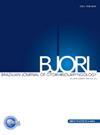Efficacy of the adjunctive use of photobiomodulation therapy in olfactory disorders in post-COVID-19 patients: A randomized controlled trial
IF 1.7
4区 医学
Q2 OTORHINOLARYNGOLOGY
引用次数: 0
Abstract
Objectives
Photobiomodulation Therapy (PBMT) is a non-invasive treatment that uses photons from the red to infrared spectrum to modulate cellular processes with anti-inflammatory and regenerative properties. This study aimed to evaluate the use of PBMT applied intranasally in patients with an impaired sense of smell after COVID-19. Methods: This proof-of-concept study was a randomized, placebo-controlled clinical trial that recruited 81 patients with olfactory disorders after SARS-CoV-2 infection (1–12 months), randomly assigned to 3 groups: controls, red light and infrared light exposure groups. PBMT was applied twice a week for five weeks, associated with prednisolone 40 mg for five days and olfactory training for 90 days from the first day of laser application. UPSIT® and subjective chemosensory scores were the outcomes collected before the first session and three months thereafter.
Results
Compared to controls, patients undergoing infrared PBMT showed more improvement in UPSIT® scores (+4.6 points, 95% CI: 1.5–7.8, p = 0.004) and a tendency towards reporting a better subjective smell score at the three-month follow-up. Response rates were 26.1% (95% CI: 6.7–45.5), 43.5% (95% CI: 21.6–65.4), and 68% (95% CI: 48.3–87.7) in the control, red and infrared groups, respectively. No major adverse events were reported.
Conclusion
Therapy with PBMT in the infrared frequency appears to be a safe option in treating post-COVID olfactory disorders when combined with a five-day use of systemic corticosteroid and 90 days of olfactory training.
Level of evidence
2.
求助全文
约1分钟内获得全文
求助全文
来源期刊

Brazilian Journal of Otorhinolaryngology
OTORHINOLARYNGOLOGY-
CiteScore
3.00
自引率
0.00%
发文量
205
审稿时长
4-8 weeks
期刊介绍:
Brazilian Journal of Otorhinolaryngology publishes original contributions in otolaryngology and the associated areas (cranio-maxillo-facial surgery and phoniatrics). The aim of this journal is the national and international divulgation of the scientific production interesting to the otolaryngology, as well as the discussion, in editorials, of subjects of scientific, academic and professional relevance.
The Brazilian Journal of Otorhinolaryngology is born from the Revista Brasileira de Otorrinolaringologia, of which it is the English version, created and indexed by MEDLINE in 2005. It is the official scientific publication of the Brazilian Association of Otolaryngology and Cervicofacial Surgery. Its abbreviated title is Braz J Otorhinolaryngol., which should be used in bibliographies, footnotes and bibliographical references and strips.
 求助内容:
求助内容: 应助结果提醒方式:
应助结果提醒方式:


